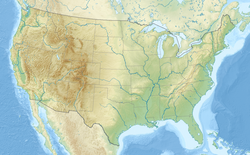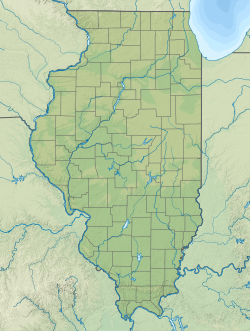Ryan Field (stadium)
 View from northeast corner in 2006 | |
Location in the United States Location in Illinois | |
| Former names | Dyche Stadium (1926–1996) |
|---|---|
| Location | 1501 Central Street Evanston, Illinois, U.S.[1] |
| Coordinates | 42°3′56″N 87°41′33″W / 42.06556°N 87.69250°W |
| Owner | Northwestern University |
| Operator | Northwestern University |
| Capacity | 47,130 (1997–2023)
Former capacity List
|
| Surface | Grass: 1997–2023 Astroturf: 1973–1996 Grass: 1926–1972 |
| Construction | |
| Broke ground | April 8, 1926[2] |
| Opened | October 2, 1926[5] |
| Renovated | 1996 |
| Expanded | 1949, 1952 |
| Closed | November 25, 2023 |
| Demolished | January 29–June 3, 2024 |
| Construction cost | $2.6 million (original)[3] ($44.7 million in 2023[4]) 1996 renovation: $20 million |
| Architect | James Gamble Rogers[1] |
| General contractor | J. B. French Construction Company[1] |
| Tenants | |
| Northwestern Wildcats (NCAA) (1926–2023) | |
| Website | |
| nusports.com/ryan-field | |
Ryan Field was a stadium in the central United States, located in Evanston, Illinois, a suburb north of Chicago. Near the campus of Northwestern University, it was primarily used for American football, and was the home field of the Northwestern Wildcats of the Big Ten Conference. Before its demolition in 2024, it was the only FBS stadium without permanent lighting, and its final seating capacity was 47,130. The stadium closed at the end of the 2023 season, and preparation for demolition began on January 29, 2024, to make way for a new Ryan Field on the site. On June 3, 2024, demolition was completed, putting a temporary pause on 97 years of Northwestern football at the site.[6][7]
Opened in 1926, it was named Dyche Stadium for William Dyche, class of 1882, Evanston mayor from 1895 to 1899 and overseer of the building project.[8] The stadium was renamed Ryan Field in 1997 in honor of the family of Aon Corporation founder Patrick G. Ryan,[9] who was then the chairman of Northwestern's board of trustees. The renaming was made by the other members of the board in recognition of the Ryan family's leadership and numerous contributions to Northwestern, including the lead gift to the Campaign for Athletic Excellence, Northwestern's fundraising drive for athletic facilities.
History
[edit]
At the time it was constructed, Dyche Stadium was considered one of the finest college football stadiums in the country.[10] The stadium originally consisted of two semi-circular grandstands on either sideline, with the west (home) sideline having a small, curved upper deck whose 2 ends abut in matching concrete towers. The purpose of the curved grandstands was to maximize the number of fans sitting close to the action.[10] A preliminary proposal featured both the west and east grandstands having symmetrical triple decks but was never realized because of cost overruns resulting from an accelerated construction schedule and average attendance figures that rarely approached 50,000.[8] End zone seating was later added in the south, and in 1952 McGaw Memorial Hall was built beyond the north end zone.
The stadium had a natural grass surface when it opened. It switched to artificial turf in 1973 and was used until 1996. Before the 1997 season, the natural grass surface was restored, and the playing surface was lowered approximately 5 feet (1.5 m) to improve sight lines from the lowest rows of the stadium.
The Chicago Bears played their first home game of the 1970 season against the Philadelphia Eagles at Dyche Stadium on September 27 as an experiment; the NFL had required that the Bears move out of Wrigley Field because its seating capacity was under 50,000, which was below the minimum set out by the newly constituted post-merger NFL. Also, the Chicago Cubs were in a September pennant race with the Pittsburgh Pirates and New York Mets in the National League East.[11] If Wrigley Field was needed for postseason baseball games, the temporary grandstand for football along the east sideline (in right and center field) would not be available until late October. After Evanston residents petitioned city officials to block the team from moving there permanently and the Big Ten Conference opposed the Bears' use of Northwestern's stadium, the Bears ended up moving to Chicago's Soldier Field the following year.
The stadium hosted the 1932 Women's (July 16) and 1948 Men's (July 9–10) US Olympic Trials for track and field. The venue also hosted the NCAA track and field championships in 1943. [12]
It also hosted the summer College All-Star Game in 1943 and 1944, which had usually been instead held at Chicago's Soldier Field. Both games were played at night with the use of temporary lights.[13] The college all-stars held their practices for the game at Dyche Stadium in years such as 1934 and 1935.[14]
Pending replacement
[edit]This section contains promotional content. (February 2023) |
On September 22, 2021, Northwestern announced that the Ryan family had donated $480 million to the university, supporting several academic initiatives and providing initial funding for replacing Ryan Field with a new stadium at the current site.[15][16] A year later, Northwestern announced initial design concepts for the new stadium, and that the Ryan family had committed to adding to their initial stadium gift.
The replacement stadium is projected to open in 2026, at a preliminary cost of $850 million, making it the most expensive college football stadium in the country. Led by the architecture firm the Rockwell Group, the stadium will have a capacity of 35,000, a reduction of 12,000 from the previous facility and the smallest football stadium in the Big Ten Conference.
However, the new Ryan Field is expected to contain elements not seen today in college football, with features and inspiration largely taken from Lower.com Field, a soccer-specific stadium opened in 2021, and other professional sports facilities, like those found in the NFL. Spectators are expected to be much closer to the action than in traditional collegiate bowl stadiums, and the new stadium is projected to be 78 percent larger than its predecessor to accommodate club and plaza areas for entertainment and dining spaces. Like other modern venues, the stadium will have a canopy for spectator weather protection and for sound retention as a competitive advantage. As was not required at the time of the original 1926 opening, the stadium will also contain required ADA compliant seats.[17][18]
Northwestern's plan to use the new stadium as a commercial concert venue had been met with opposition from stadium neighbors and other Evanston residents.[19] Issues included Northwestern's alleged failure to address issues of noise, parking, traffic congestion, and public safety.[20] Additionally, some have questioned the stadium's continuing to have a property tax exemption while being used for commercial purposes.

On January 20, 2024, it was announced that a demolition process, without explosives, would begin on January 29. The process is expected to take 4 to 6 months, after confirmation that a new, $850 million stadium would replace the current, aging one.[21]
Renaming controversy
[edit]Northwestern's decision to rename Dyche Stadium to Ryan Field defied the university's own 1926 resolution that forbade such a change. School officials said that a private institution can override previous boards' decisions, and dismissed the earlier resolution as a "show of appreciation." But NU did not explain why a mere gesture of appreciation would expressly state that any football stadium at any location would retain the name Dyche, as indeed the 1926 resolution does. The Dyche family was not notified of the change; NU claimed that the only descendant they found was a grandniece, despite other family members living in Chicago and being listed in the phone book. After the family protested, NU said it was willing to install an informational plaque at the stadium, noting its former name.[22]
Transportation
[edit]The closest transit stations are Metra commuter railroad's Central Street station and Chicago Transit Authority's Central station on the Purple Line.
In popular culture
[edit]Parts of The Express: The Ernie Davis Story, a 2008 film about Syracuse University Heisman Trophy winner Ernie Davis starring Rob Brown as Davis, and Dennis Quaid as Davis' Syracuse coach, Ben Schwartzwalder, were filmed at Ryan Field.[23]
Parts of Four Friends, a 1981 film directed by Arthur Penn, were filmed at Dyche Stadium.
See also
[edit]References
[edit]- ^ a b c "Ryan Field". Ballparks.com. Archived from the original on January 20, 2017. Retrieved November 13, 2013.
- ^ "Northwestern Starts Work on New $1,000,000 Stadium". Chicago Daily Tribune. April 8, 1926. p. 26. ProQuest 180791926. Retrieved November 13, 2013.
- ^ "Northwestern's New Field Named Dyche Stadium". Chicago Tribune. October 28, 1926. Archived from the original on February 1, 2013. Retrieved September 28, 2011.
- ^ 1634–1699: McCusker, J. J. (1997). How Much Is That in Real Money? A Historical Price Index for Use as a Deflator of Money Values in the Economy of the United States: Addenda et Corrigenda (PDF). American Antiquarian Society. 1700–1799: McCusker, J. J. (1992). How Much Is That in Real Money? A Historical Price Index for Use as a Deflator of Money Values in the Economy of the United States (PDF). American Antiquarian Society. 1800–present: Federal Reserve Bank of Minneapolis. "Consumer Price Index (estimate) 1800–". Retrieved February 29, 2024.
- ^ LaTourette, Larry (2005). Northwestern Wildcat Football. Chicago: Arcadia Publishing. p. 35. ISBN 0-7385-3433-1. Retrieved September 28, 2011.
- ^ "Ryan Field demolition set to begin the week of Jan. 29". Northwestern Now. Northwestern University. January 19, 2024. Retrieved January 30, 2024.
- ^ "Construction update from the Central Street Consortium". Ryan Field: A New Vision. Northwestern University. June 6, 2024. Retrieved September 4, 2024.
- ^ a b Pope, Ben. "Football: Northwestern and Ryan Field’s near-ascendency into college football glory," The Daily Northwestern (Northwestern University), Tuesday, November 22, 2016. Retrieved March 10, 2022.
- ^ "Northwestern University Campus Maps: Ryan Field". maps.northwestern.edu. Retrieved 2023-12-21.
- ^ a b Pridmore, Jay (2000). Northwestern University: Celebrating 150 Years. Northwestern University Press. p. 126.
- ^ "Pennant race at a glance". Spokesman-Review. (Spokane, Washington). September 16, 1970. p. 16.
- ^ "DI Men's Track & Field (O) Championship History | NCAA.com". www.ncaa.com. Retrieved 2022-01-21.
- ^ "Recalling the Night That Nu Lit up the Big 10". Chicago Tribune. 31 August 1988.
- ^ Schmidt, Raymond (2001). Football's Stars of Summer: A History of the College All-Star Football Game Series of 1934-1976. Lanham, Maryland; London, England: Scarecrow Press. ISBN 9780810840270. Retrieved April 21, 2015.
- ^ "Ryan Family Makes Largest Gift in Northwestern History" (Press release). Northwestern Wildcats. September 22, 2021. Retrieved September 30, 2022.
- ^ "Funded by the same $480 million gift as stadium proposal, Ryan Institute launches at Northwestern". Chicago Tribune. 2023-09-06. Retrieved 2024-09-11.
- ^ "Northwestern reveals plans for $850M Ryan Field". ESPN.com. 2024-11-18. Retrieved 2024-11-20.
- ^ "A Bold New Vision for College Football Unveiled at Northwestern". Northwestern Athletics. November 18, 2024.
- ^ Schmidt, Corey (2022-11-07). "Residents worry Northwestern's new Ryan Field proposal could turn Evanston into Wrigleyville". Chicago Tribune. Retrieved 2024-09-11.
- ^ "Guest essay: NU misled us and used our stadium working group as a fig leaf". Evanston RoundTable. 2023-03-25. Retrieved 2024-09-11.
- ^ "Northwestern gets green light to move forward with Ryan Field rebuild". news.northwestern.edu.
- ^ Morrissey, Rick (September 19, 1997). "For Dyche Clan, Perpetuity Didn't Last Long". Chicago Tribune. Chicago, Illinois. Retrieved July 10, 2016.
- ^ Bhattarai, Abha (May 1, 2007). "Bringing Hollywood to NU". Daily Northwestern. Northwestern University. Archived from the original on May 3, 2007. Retrieved May 6, 2007.




